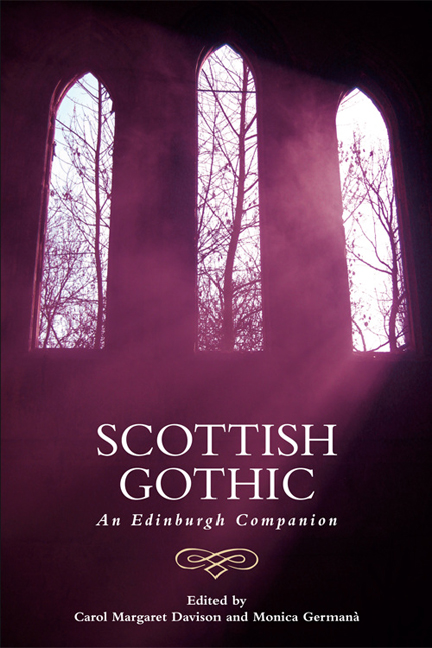Book contents
- Frontmatter
- Contents
- Acknowledgements
- 1 Borderlands of Identity and the Aesthetics of Disjuncture: An Introduction to Scottish Gothic
- 2 ‘The Celtic Century’ and the Genesis of Scottish Gothic
- 3 The Politics and Poetics of the ‘Scottish Gothic’ from Ossian to Otranto and Beyond
- 4 Robert Burns and the Scottish Bawdy Politic
- 5 Scottish Gothic Drama
- 6 Scottish Gothic Poetry
- 7 Calvinist and Covenanter Gothic
- 8 Gothic Scott
- 9 Gothic Hogg
- 10 ‘The Singular Wrought Out into the Strange and Mystical’: Blackwood's Edinburgh Magazine and the Transformation of Terror
- 11 Gothic Stevenson
- 12 J. M. Barrie's Gothic: Ghosts, Fairy Tales and Lost Children
- 13 The ‘nouveau frisson’: Muriel Spark's Gothic Fiction
- 14 Scottish Gothic and the Moving Image: A Tale of Two Traditions
- 15 New Frankensteins; or, the Body Politic
- 16 Queer Scottish Gothic
- 17 Authorship, ‘Ghost-filled’ Islands and the Haunting Feminine: Contemporary Scottish Female Gothic
- Notes on Contributors
- Index
4 - Robert Burns and the Scottish Bawdy Politic
Published online by Cambridge University Press: 20 December 2017
- Frontmatter
- Contents
- Acknowledgements
- 1 Borderlands of Identity and the Aesthetics of Disjuncture: An Introduction to Scottish Gothic
- 2 ‘The Celtic Century’ and the Genesis of Scottish Gothic
- 3 The Politics and Poetics of the ‘Scottish Gothic’ from Ossian to Otranto and Beyond
- 4 Robert Burns and the Scottish Bawdy Politic
- 5 Scottish Gothic Drama
- 6 Scottish Gothic Poetry
- 7 Calvinist and Covenanter Gothic
- 8 Gothic Scott
- 9 Gothic Hogg
- 10 ‘The Singular Wrought Out into the Strange and Mystical’: Blackwood's Edinburgh Magazine and the Transformation of Terror
- 11 Gothic Stevenson
- 12 J. M. Barrie's Gothic: Ghosts, Fairy Tales and Lost Children
- 13 The ‘nouveau frisson’: Muriel Spark's Gothic Fiction
- 14 Scottish Gothic and the Moving Image: A Tale of Two Traditions
- 15 New Frankensteins; or, the Body Politic
- 16 Queer Scottish Gothic
- 17 Authorship, ‘Ghost-filled’ Islands and the Haunting Feminine: Contemporary Scottish Female Gothic
- Notes on Contributors
- Index
Summary
Where are the Jesters now? the Men of Health
Complexionally pleasant? (Blair 1743: 9; original emphasis)Oft-times, Lowland Scots wrote of death in the eighteenth century without engaging in what we now call ‘Scottish Gothic’. Witness Robert Blair, above, Edinburgh-born, as he brings the adverb ‘complexionally’ to an otherwise straightforward example of the ancient and melancholy ubi sunt trope.1 Blair's melancholy is here expressed in a fantastically influential poem called The Grave (1743). Blair's fascinating poem, to which this chapter will return at its conclusion, is rightly held to be foundational for the study of what until recently was thought of as a pan- British ‘Graveyard School’ of poetry. That label describes an extremely loose collection of mid-eighteenth-century authors whose poems were written in a more or less ‘standard’ English, and often troped the graveyard. The category invokes such disparate poets as the English-born Thomas Gray and Edward Young or the Scottish-born James Thomson and James Beattie. There are many good poems on death, demise, and the supernatural realm written by Scottish and English authors during the eighteenth century. What actually differentiates a Lowland ‘Scottish Gothic’ poetry from not dissimilar poetry on death (‘Gothic’ or otherwise) in the eighteenth century is not only a turn to a Scots lexis but also a profound and foundational localism. The incorporation of local thought marks the difference between Scottish writing of the Gothic and all the other forms of expression that have come to take the adjective ‘Gothic’. Since the eighteenth century, every attempt to ground a Gothic work in a particular time and place relies upon the temporal and spatial architecture laid down by early practitioners in the Scottish eighteenth century. What this chapter argues is that Scottish Gothic verse needs to be read carefully both in terms of its emergence in time as well as its geographical specificity. Consider the opening quotation from Robert Blair: his title offers the reader just ‘the’ grave. The definite article (‘the …’) is most indefinite: it is designed to indicate all of our graves; from that there follows the poem's ambitious scope. For the poem to succeed on its own terms, it cannot offer ‘that spot just there’ as we will find the Burnsian locale to be.
- Type
- Chapter
- Information
- Scottish GothicAn Edinburgh Companion, pp. 42 - 58Publisher: Edinburgh University PressPrint publication year: 2017

